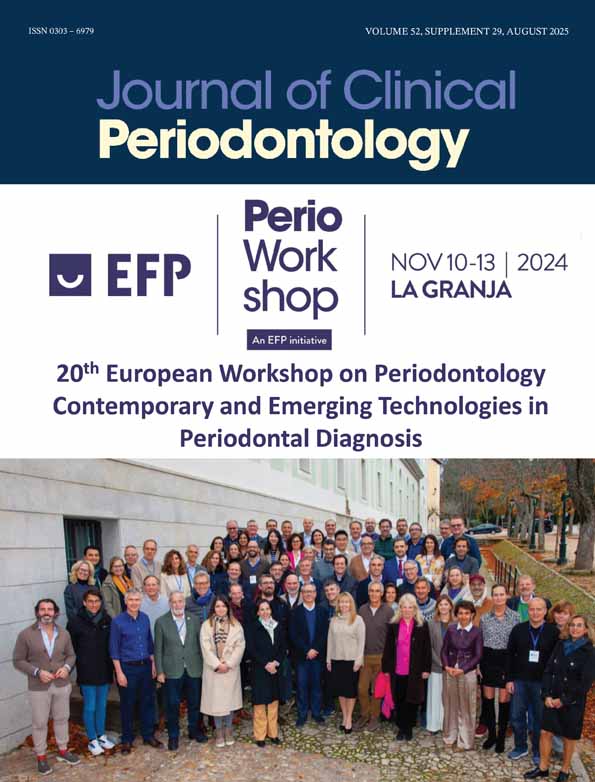A placebo-controlled multi-centred evaluation of an anaesthetic gel (Oraqix®) for periodontal therapy
Abstract
enAims: Six Canadian dental schools investigated the ability of a thermosetting gel containing 25 mg/g prilocaine and 25 mg/g lidocaine as active agents to produce analgesia in periodontal pockets utilizing a randomized, double-blind, placebo-controlled study.
Materials and Methods: The study consisted of 130 patients, each of whom received the active or placebo gel in periodontal pockets in one quadrant of the mouth for 30 s prior to periodontal debridement (scaling and root planing). Pain was measured using both a 100-mm Visual Analogue Scale (VAS) and a Verbal Rating Scale (VRS).
Results: The median VAS pain score for the patients treated with the anaesthetic gel was 5 mm (range 0–85 mm) as opposed to 13 mm (range 0–79 mm) in the placebo-treated patients (P=0.015). There was no significant difference in the percentage of patients reporting no or mild pain (78% and 76% for the anaesthetic gel and placebo, respectively). No significant differences were seen in patient demographics, or mandible versus maxilla.
Conclusions: The VAS pain scores showed that the anaesthetic gel 5% was statistically more effective than the placebo in reducing pain during periodontal debridement.
Zusammenfassung
deAn 6 Kanadischen Universitätszahnkliniken wurde ein thermisch sich verfestigendes Anästhesie-Gel in einer randomisierten Plazebo-kontrollierten Doppel-Blind-Studie hinsichtlich seiner schmerzlindernden Wirkung untersucht. Als aktive Wirkstoffe enthält das Gel 25 mg/g Prilocain und 25 mg/g Lidocain. In die Studie wurden 130 Patienten aufgenommen, welche in die Taschen eines Quadranten des Gebisses 30 Sekunden vor dem parodontalen Debridement (Scaling und Wurzelglättung) entweder das aktive oder das Plazebo-Gel bekamen. Der Schmerz wurde durch eine 100-mm Visuelle Analog-Skala (VAS) und eine Verbale Rating-Skala (VRS) bestimmt. Der mediane VAS-Schmerzwert betrug für Patienten, die mit Anästhesie-Gel behandelt wurden, 5 mm (Schwankungsbreite 0-85 mm) im Gegensatz zu 13 mm (Schwankungsbreite 0-79 mm) für die mit Plazebo behandelten Patienten (p=0,015). Es gab keinen signifikanten Unterschied zwischen dem Prozentsatz der Patienten, welchen über keinen oder nur leichten Schmerz berichteten (78% und 76% für das Anästhesie-Gel bzw. das Plazebo). Es wurden keine signifikanten Unterschiede bei den demographischen Daten der Patienten oder hinsichtlich der Wirkung im Ober- versus Unterkiefer beobachtet. Die VAS-Schmerzwerte zeigten, dass das 5%ige-Anästhesie-Gel bei der Schmerzreduktion während des parodontalen Debridements statistisch effektiver ist als das Plazebo.
Résumé
frSix écoles dentaires canadiennes ont fait une étude sur l'abilité d'un gel thermodurcissable contenant comme agents actifs 25 mg/g de prilocaine et 25 mg/g de lidocaine à produire une analgésie dans une poche parodontale par le moyen d'une étude au hasard et à l'aveuglette avec placebo.
Les 130 malades étudiés ont tous reçu soit le gel actif ou le gel placebo dans une poche parodontale d'un quadrant de leur bouche pendant 30 seconde avant un débridement parodontal (détartrage et curetage de la surface de la racine). Leur réaction à la douleur fut mesurée en utilisant une Échelle Analogue Visuelle (VAS) de 100-mm et une Échelle de l'Estimation Verbale (VRS).
Les résultats médians de la douleur sur l'échelle VAS pour les malades traités avec le gel anesthésique était de 5 mm (sur une gamme de 0 à 85mm) et de 13mm (sur une gamme de 0 à 79mm) pour les malades traités avec le gel placebo (P=0.015).
Il n'y avait pas de différence notable dans le pourcentage des malades ressentant peu ou pas de douleur (78% pour le gel anesthésique et 76% pour le placebo). Il n'y avait pas de différence marquée dans la démographie des malades ou entre le maxillaire inférieur et supérieur.
Les résultats du VAS ont démontré que le gel anesthésique à 5%était statistiquement plus efficace que le placebo pour réduire la douleur lors d'un débridement parodontal.




